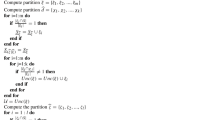Abstract
Rough sets help in finding significant attributes of large data sets and generating decision rules for classifying new instances. Though multiple regression analysis, discriminant analysis, log-it analysis and several other techniques can be used for predicting results, they consider insignificant information also for processing which may lead to false positives and false negatives. In this study, we proposed rough set based decision rule generation framework to find reduct and to generate decision rules for predicting the Decision class. We conducted experiments over data of Portuguese Banking institution. From the proposed method, the dimensionality of data is reduced and decision rules are generated which predicts deposit nature of customers by 90% accuracy.

Similar content being viewed by others
References
Deger A and Adem A 2011 Bank specific and macroeconomic determinants of commercial bank profitability—empirical evidence from Turkey. Bus. Econ. Res. J. 2: 139–152
Sergio M and Paulo C 2014 A data-driven approach to predict the success of bank telemarketing. Decis. Support Syst. 62(2014): 22–31
Joaquin A, Rebecca M B and Frank P A C 2014 Classification with decision trees from a nonparametric predictive inference perspective. Comput. Stat. Data Anal. 71(2014): 789–802
Mu-Yen C 2011 Predicting corporate financial distress based on integration of decision tree classification and logistic regression. Expert Syst. Appl. 38(2011): 11261–11272
Pawlak Z 2002 Rough set theory and its applications. J. Telecommun. Inf. Technol. 3: 7–10
Eric C C T, Chen D and Daniel S Y 2008 Approximations and reducts with covering generalized rough sets. Comput. Math. Appl. 56(2008): 279–289
Francis E H T and Lixiang S 2002 Economic and financial prediction using rough sets model. Eur. J. Oper. Res. 141(2002): 641–659
You-Shyang C 2012 Classifying credit ratings for Asian banks using integrating feature selection and the CPDA-based rough sets approach. Knowl. Based Syst. 26(2012): 259–270
Hsu-Hao Y and Chang-Lun W 2009 Rough sets to help medical diagnosis—Evidence from a Taiwan’s clinic. Expert Syst. Appl. 36(2009): 9293–9298
Duoqian M, Qiguo D and Hongyun Z 2009 Rough set based hybrid algorithm for text classification. Expert Syst. Appl. 36(2009): 9168–9174
Zuqiang M and Zhongzhi S 2012 Extended rough set-based attribute reduction in inconsistent incomplete decision systems. Inf. Sci. 204(2012): 44–69
Changzhong W, Mingwen S, Baiqing S and Qinghua H 2015 An improved attribute reduction scheme with covering based rough sets. Appl. Soft Comput. 26: 235–243
Jia-yang W and Jie Z 2009 Research of reduct features in the variable precision rough set model. Neurocomputing 72: 2643–2648
Malcolm B 2001 Reducts within the variable precision rough sets model A further investigation. Eur. J. Oper. Res. 134(2001): 592–605
Al-Radaideh Q A, Sulaiman M N, Selamat M H and Ibrahim H 2005 Approximate reduct computation by rough sets based attribute weighting. IEEE International Conference on Granular Computing, vol 2, pp 383–386
Wang P-C 2011 Efficient hash-based approximate reduct generation. IEEE International Conference on Granular Computing, Kaohsiung, pp 703–707
Asuncion A and Newman D 2012 University of California, School of Information and Computer Science, UCI machine learning repository. Irvine
Author information
Authors and Affiliations
Corresponding author
Rights and permissions
About this article
Cite this article
Sumalatha, L., Uma Sankar, P. & Sujatha, B. Rough set based decision rule generation to find behavioural patterns of customers. Sādhanā 41, 985–991 (2016). https://doi.org/10.1007/s12046-016-0528-1
Received:
Revised:
Accepted:
Published:
Issue Date:
DOI: https://doi.org/10.1007/s12046-016-0528-1




